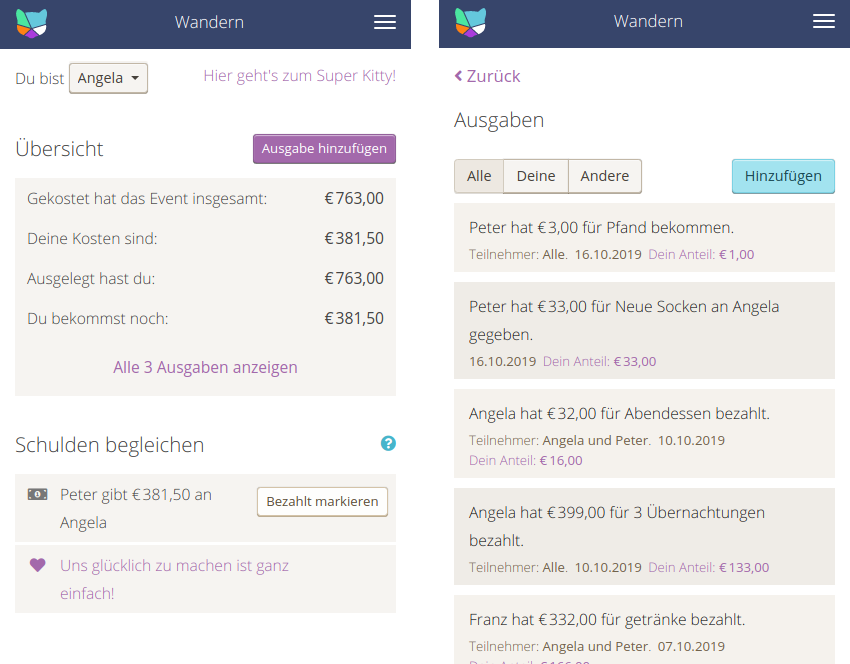Should you build a native app or a web app?
Native app or no native app? That’s a question that is regularly posed here at Kittysplit Towers. Kittysplit is a moderately successful webapp for splitting expenses in a group with 70.000 users per month. It is responsive and works pretty well on a mobile browser: 80% of our users are mobile. Yet we often get the request: “please build an app!” 🙏. What our users want, of course, is a “native” app that can be installed via the App Store. A webapp, on the other hand, is an app that works in your browser (i.e. Chrome or Safari).
Surely the answer is to build an app! Right? Every company worth its salt has an app.

Let’s dive in. We’re actually pretty sure that many of our long dead competitors sealed their fate by deciding they needed an app. Once you have a good-enough webapp, the advantages of an additional native app are not that great.
The case for having an app
What are the advantages of having a native app? Let’s go through the list and then see what the other side has to say.
1. Do it for the mobile users
If 80% of Kittysplit users are on mobile, surely we should give them an app!
2. Enables offline access
People sometimes go to places with no Wi-Fi access (foolish!) where they incur costs that need splitting. With an app, they could enter the expenses in offline mode and then things could sync up once they got back online.
3. An App Store shows your reputation and trust
It’s easier to convince potential users that your product is worthwhile and reliable if you have a large number of installs and a bunch of positive ratings in the App Store.
4. Allow push notifications
Push notifications are the crack cocaine of getting users to return to your app. In our case, users could be informed that expenses have been added or edited for kitties that they’re involved with.
5. Allow an icon on the home screen
Once a user is constantly being confronted with your app icon on her phone, she’ll be much more likely to open it.
6. Bragging rights
We’re a startup from Berlin, so we absolutely need to have an app which we can wave around in smoky bars at three in the morning.
A pretty solid case so far. Let’s look at what the other side has to say.
The case against having a native app
So what are the disadvantages of having an app?
1. Native apps costs money — lots of it.
Even the most basic app which does little more that say “Hello World” will have a price tag of 5k EUR. Once the app does fancy stuff like talking to a server that number skyrockets to 50k plus in no time. And then there’s the kicker: you’re going to have to build the app twice, once for iOS and once for Android. Yes, we know about cross-platform solutions, but they (still) suck.
If you build a solid webapp on the other hand, you’ll serve everyone, including individualists who use Windows Phones and other wonderful contraptions.
In our case, money is not the issue (because we have none) but time is. The same argument still applies, however. As Richard Branson said: “Time is the new money”.
2. Developing native apps is painful
Making apps is hard. It’s getting easier, but it’s still much harder than making webapps. Quality assurance is an issue, especially on Android due to fragmentation. Making new releases is also a pain, especially on iOS, due to the review process.
When you update a webapp, on the other hand, every user will instantly get the update and probably won’t even realise.
Then there’s the issue of development speed. If you are supporting multiple platforms, you’ll need to roll out features on all of them synchronously — or at least ensure that missing features don’t break the product. This will slow down your product development drastically. Again, this is not an issue if you only have one platform.
3. Onboarding for native apps is rubbish
If you want your product to grow virally then you need to have a really quick onboarding process. This is exactly what Kittysplit currently has: when you’re sent a link to a Kitty, it takes 2 clicks to get inside, and you’re ready to go. There’s no way that any app installation plus identification process could ever be that simple.
Onboarding is probably where we’re strongest compared to the competition (coupled with the fact that users don’t need to register). An app would be a big step backwards for us.
4. Offline access
OK, here a native app wins hands down. Still, consider the fact that being in a situation with zero internet access is becoming rarer with each passing year. When we go on holiday these days we buy a data pack, which was really expensive or not even possible five years ago.
And then there are so-called progressive webapps which solve the problem of being offline. But more on that another day.
The verdict
In our case, the verdict is clear: we don’t need an app (right now). It makes no sense to greatly slow down our development and exposing our new users to all kinds of onboarding issues for the sake of improving a relatively uncommon scenario.
Of course, there are many cases where a native app is the only way to go (photos, location-based background services or anything that relies on sensors or synchronisation). Nonetheless, there are many startups out there, not just our competitors, who would do themselves a huge favor by not putting too much priority on a native app — and maybe making do without one altogether.